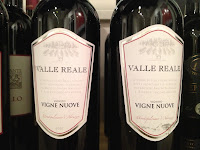I was asked to give a talk and conduct a tasting on the wines of Molise, Italy recently. I spent a lot of time working on it, which explains why I haven't been posting any updates. Now that it's over, I wanted to write about the event and the region.
The attendees were members of the Cultural Association of the Molise Region headed by the former mayor of one of the towns in Molise.
 Where is Molise you ask? It's sandwiched between Abruzzo to the north, Lazio and Campagnia to the west, Puglia to the south and the Adriatic Sea to the east. It's the 20th political region of Italy (meaning most recent as 1963) and the second smallest in Italy after the Valle d'Aosta in the north. Before 1963 it was part of Abruzzo, so you look at an older map of Italy, it may say "Abruzzo e Molise". For reasons unknown, it separated and became its own province. There are approximately 300,000 inhabitants in the region, mostly in the two main cities of Campobasso and Isernia.
Where is Molise you ask? It's sandwiched between Abruzzo to the north, Lazio and Campagnia to the west, Puglia to the south and the Adriatic Sea to the east. It's the 20th political region of Italy (meaning most recent as 1963) and the second smallest in Italy after the Valle d'Aosta in the north. Before 1963 it was part of Abruzzo, so you look at an older map of Italy, it may say "Abruzzo e Molise". For reasons unknown, it separated and became its own province. There are approximately 300,000 inhabitants in the region, mostly in the two main cities of Campobasso and Isernia.There are 4 main industries in Molise -- agriculture, livestock raising, food processing and clothing manufacturing. Interestingly enough, there is a Fiat plant there.
Going back to the wine part, grapes have been grown in this region since ancient times. Up until recently, wines here were made for local consumption by cooperative wineries. They also produce wines in bulk. There has been a shift towards improving quality through improved vineyard sites (from the mountains towards the coast), using modern winemaking production techniques (i.e. increasing sanitation methods, stainless steel fermentation), yet trying to preserve the native grapes to this region for the export market.
We tasted 6 wines, 3 from the Molise region. The first was a sangiovese from Di Majo Norante. We compared that with another sangiovese from a famous region, Chianti. This particular chianti was from the Colli Senesi, the largest of the 7 Chianti zones. The Chianti was more aromatic, fruitier and had a longer length. The Di Majo Norante sangiovese was simple and perfect for eating simple foods.
 The third wine was a tintilia, a native grape to Molise and arrived to the region during the Spanish domination. It means 'tinto' for red in Spanish. It is considered Molise's most important grape variety. It is medium acidity, high in alcohol, medium to high tannins, intensely pigmented and full bodied. The Catabbo tintilia was very full in the mouth. It was so much so, it felt 'chewy'. We talked about the price, which was $22 and whether we thought it was worth the money. Perhaps it was a function of the novelty, since I sourced the wine in Cleveland, Ohio! It's not a wine to be found easily.
The third wine was a tintilia, a native grape to Molise and arrived to the region during the Spanish domination. It means 'tinto' for red in Spanish. It is considered Molise's most important grape variety. It is medium acidity, high in alcohol, medium to high tannins, intensely pigmented and full bodied. The Catabbo tintilia was very full in the mouth. It was so much so, it felt 'chewy'. We talked about the price, which was $22 and whether we thought it was worth the money. Perhaps it was a function of the novelty, since I sourced the wine in Cleveland, Ohio! It's not a wine to be found easily. The next flight of wines was the Di Majo Norante Ramitello, which was a blend of 80% montepulciano, 20% aglianico. This montepulciano is not to be confused with Montepulciano from Tuscany. It's an Italian grape variety planted throughout central Italy. It is deeply pigmented, low in acidity, high in alcohol, soft tannins and is medium-to-full bodied. We discussed why wines are blended (like cooking -- each grape has a quality that adds something to the blend) and how aglianico changed the composition of this wine. We also tasted the Valle Reale Montepulciano d'Abruzzo from the neighboring region of Abruzzo to the north. It was a 100% montepulciano and was very easy to drink and lighter in body than the Ramitello.
The next flight of wines was the Di Majo Norante Ramitello, which was a blend of 80% montepulciano, 20% aglianico. This montepulciano is not to be confused with Montepulciano from Tuscany. It's an Italian grape variety planted throughout central Italy. It is deeply pigmented, low in acidity, high in alcohol, soft tannins and is medium-to-full bodied. We discussed why wines are blended (like cooking -- each grape has a quality that adds something to the blend) and how aglianico changed the composition of this wine. We also tasted the Valle Reale Montepulciano d'Abruzzo from the neighboring region of Abruzzo to the north. It was a 100% montepulciano and was very easy to drink and lighter in body than the Ramitello. 

Finally, we tasted an aglianico, which originated in Greece and brought to Italy by Greek settlers. It is a full bodied red with high tannins, high acid and deep pigmentation. It is a wine that is unique to the south of Italy and perfect for rich regional foods.
After the tasting, our hosts presented the guests with homemade pasta dishes with truffles, pesto and artichokes. Additionally, we were treated to locally made Molisano cheeses which were hand carried from abroad. Don't tell the customs officials!


